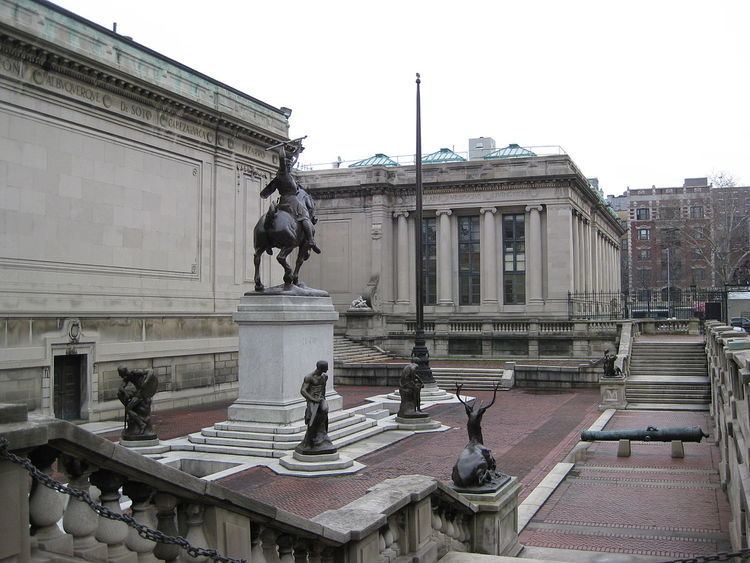Built 1907 Designated NYCL January 9, 1979 Added to NRHP 30 May 1980 | NRHP Reference # 80002667 Opened 1907 | |
 | ||
Location Architectural styles Beaux-Arts architecture, American Renaissance Similar Hispanic Society of America, Church of the Intercession, Our Lady of Esperanza Church, George Gustav Heye Ce, Harbor Defense Museum | ||
Tourist in your own town 24 hispanic society of america audubon terrace
Audubon Terrace, also known as the Audubon Terrace Historic District, is a landmark complex of eight early-20th century Beaux Arts/American Renaissance buildings located on the west side of Broadway, bounded by West 155th and West 156th Streets, in the Washington Heights neighborhood of upper Manhattan, New York City. Home to several cultural institutions, the architecturally complementary buildings, which take up most of a city block, are arranged in two parallel rows facing each other across a common plaza. The complex is directly across 155th Street from Trinity Church Cemetery.
Contents
- Tourist in your own town 24 hispanic society of america audubon terrace
- History
- Resident institutions
- References
Although the 157th Street subway station on the 1 train is one block away, the complex's location considerably north of midtown has resulted in a perceived detriment to easy access for visitors, especially those from out of town. The complex was designated a New York City landmark in 1979, and was added to the National Register of Historic Places in 1980.
History
Named for naturalist and artist John James Audubon, on whose former land the complex sits, Audubon Terrace was commissioned in 1907 by Archer M. Huntington, the heir to the Southern Pacific Railroad fortune, a philanthropist and a Spanish scholar. The master plan for the site was drawn up by his cousin, architect Charles P. Huntington, in 1908. Archer Huntington chose the location at a time when the two centuries old northward march of fashionable residences and cultural institutions seemed likely to transform the largely rural area. He assumed that other museums and learned societies would soon join him, creating an intellectual citadel atop the island's heights. The widespread adoption of the elevator and steel framing at this time, however, led Manhattan real estate to begin to develop vertically instead and New York's other great cultural institutions failed to follow suit - in fact, most of the organizations which located on Audubon Terrace were headed by or strongly connected to Huntington.
In 1904, Huntington had founded the Hispanic Society of America, and had commissioned Charles Huntington to design a building for the new institution on the grounds of what would become Audubon Terrace. Huntington's original building was constructed from 1904–08, with a west wing by Huntington added in 1915 along with an east wing designed by Erik Strindberg. In 1923-30, a library for the Society was added across the plaza, designed by H. Brooks Price. The next institutions to locate on the site all had their buildings designed by Charles Huntington: the American Numismatic Society, built in 1907, the American Geographical Society (1911), the Spanish-speaking Church of Our Lady of Esperanza (1909–12; West 156th Street addition and remodeling in 1924 by Lawrence G. White, Stanford White's son), and the Museum of the American Indian (1915–22).
In 1921-23, William M. Kendall of McKim, Mead & White designed an Anglo-Italian Renaissance building for the American Academy of Arts and Letters and the National Institute of Arts and Letters, which was followed by an auditorium and gallery for them designed by Cass Gilbert and built in 1928-30. The two organizations merged as the American Academy and Institute of Arts and Letters in 1976.
The plaza surrounding these buildings is the location of a number of sculptures executed by Anna Hyatt Huntington, Archer Huntington's wife, between 1927 and 1944. These include a large equestrian statue of the legendary Spanish knight El Cid (1927), in front of the Hispanic Society Library.
Resident institutions
A number of the original institutions are no longer resident on the Terrace:
Of the remaining original institutions, the Hispanic Society has, since 2006, been considering a move to larger quarters downtown. The Society maintains a library and a museum with an important collection of art and artifacts from the Iberian peninsula, as well as from Central and South America. It is normally open daily except Mondays; Tuesday through Saturdays from 10 am to 4:30 pm, and Sundays from 1 pm to 4 pm.
The American Academy of Arts and Letters was founded in 1898. Its gallery is open to the public Tuesdays through Saturdays from 1 pm to 4 pm, except from March to June, when it is open Thursdays through Sundays from 1 pm to 4 pm.
